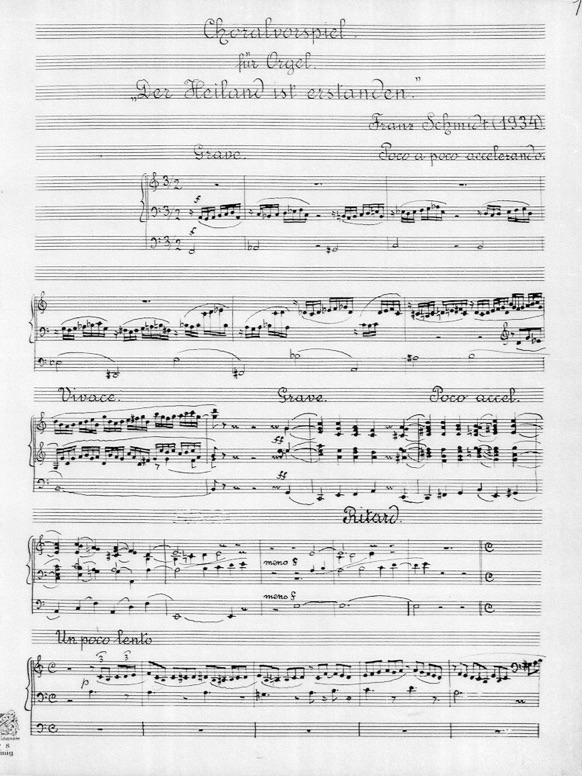
Franz Schmidt as cellist
after an etching of Anton Karlinsky
(Wien Museum)
FRANZ SCHMIDT (1874 – 1939)
Franz Schmidt, one of the last great Late Romantics of the 20th Century, was born on December 22, 1874 in Pressburg. The extraordinary musical ability of the child was encouraged in the parent’s house by house concerts and the first piano lessons given by his mother. The organ has an important place in the musical experience of the boy Franz Schmidt: he had his first organ lessons in the Pressburger Dom.
From 1890 – after the Schmidt family had moved to Vienna – Schmidt attended the ‘Conservatory of the Society of the Friends of Music’. There he studied composition under Robert Fuchs and cello under Ferdinand Hellmesberger, and he successfully managed to defy the abhorred piano lessons under Theodor Leschetitzky.
As a cellist, Schmidt was as a member of the Vienna Philharmonic Orchestra for fifteen years from 1896. Since 1901 he worked as a teacher for cello at the conservatory, after the socialisation into an academy he was appointed to a professorship for piano in 1914, and for counterpoint and composition in 1922. In the following years he was – alternating with Joseph Marx – director and rector of the academy and the conservatory respectively.
After a few years a physical illness was beginning to show, which was finally the reason for his retirement in 1937. Schmidt’s last years were characterised by physical breakdowns but also maxima of intensive creative power. Successes and tributes, amongst others the honorary doctorate of the University of Vienna were awarded to him until shortly before his death on February 11, 1939.
In his works, Franz Schmidt takes an intermediate position between the last rush of High Romantic sound style and the completely different music of the 20th Century which is affected by the rapid development of science and technology. The initial point of his work was a “highly developed play- and forming instinct” (Erich Schenk) that represents the “minstrel-like” element in Schmidt’s style.
In his most important composition and opus summum, the Oratorio “Das Buch mit sieben Siegeln”, Schmidt accomplished the fundamental transformation into a musician of expression by creating a work of the utmost visionary suggestive puissance, from “the deep religious man and artist’s point of view”.

Franz Schmidt in his home in Perchtoldsdorf with the score of „Das Buch mit sieben Siegeln“
(Photo Brühlmeyer, Vienna)
Schmidt’s oeuvre for orchestra becomes manifest in four symphonies, two variation pieces, tow piano concerts and the orchestra setting of the Chaconne for organ. His chamber musical work is especially devoted to the piano which became one of the most individual expression forms of the composer. Beside only two piano pieces Franz Schmidt created lots of organ compositions, numerically almost one half of his entire oeuvre. The formal principle of the fugue dominates these 20 compositions. Schmidt’s organ music originates from an era of dispute about the domination of the ideal of the romantic concert organ versus the historic baroque organ. For Schmidt, always the musical statement was essential and so he went the way from individualistic sound colouring to objectifying performance, but without becoming a sound ascetic, not even on the organ. Schmidt’s ideal conception of the organ enables the composer to keep the bliss of Viennese music and Late Romantic mood expression from melting and to avert them in solid forms.
Nearly incredible things are told in numerous anecdotes about Schmidt as musician and teacher: whether he possessed – without exercising – a pianistic ability that amazed even virtuosi, or he knew the most difficult parts of symphonies, operas, and of all piano concerts from Bach to Brahms, of Tchaikowsky or Grieg by heart. Schmidt’s heritage lives on in many of his students and in many of them the “minstrel-like” attitude, a specific of the Viennese art of interpretation can be noticed, in the Viennese Piano- and Organ School as well as in composition.
Helga Michelitsch

„Der Heiland ist erstanden“
(Österreichische Nationalbibliothek – Musiksammlung)

(Archiv der Gesellschaft der Musikfreunde in Wien)

of the conservatory in Vienna, 1927
(Photo: Fayer)

